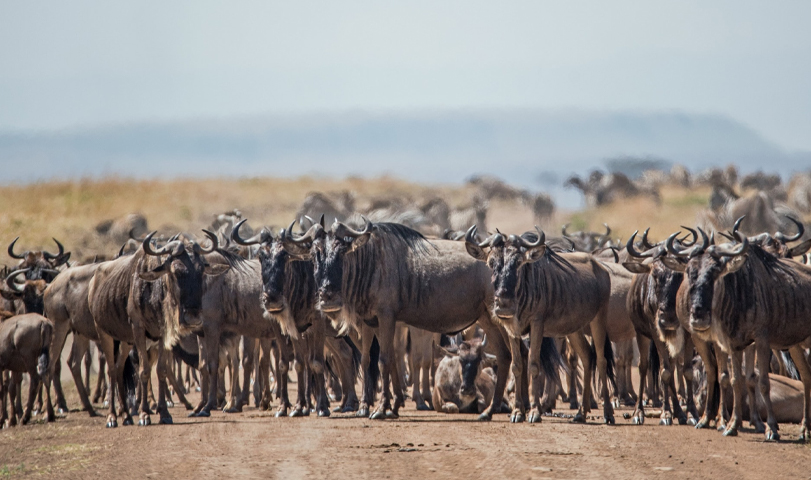Serengeti Wildebeest Migration Safari
Africa’s race for life
Serengeti Wildebeest Migration Safari
The Great Migration Of Wildebeest – Tanzania!
Every year, the vast herds of wildebeest embark on a long-distance migration that coincide with the annual rain fall patterns and grass growth. Following the short rainy season in November, the herds of wildebeest arrive to the short-grass plains of the Serengeti around November.
The short-grass plains are located in the area east and south of the Seronera, around Ndutu and the northern Ngorongoro Conservation area. Herds of wildebeest and zebra can be seen across these plains as they feed on the nutrient rich grasses. The majority of the wildebeest calve around February.

The Great Migration
They normally stay in the area till April and then start moving west towards to the Western Corridor of the Serengeti National Park. 6-days Migration wildlife safari, holiday packages, indicate and focus to increase your chance to see the great Serengeti wildebeest migration. We have indicate the itinerary to include the Lake Ndutu area, southern Serengeti and central Serengeti National Park where the majority of the wildebeest migration can normally be found from December through to April. To save on unnecessary travel time and to increase your game viewing time, this itinerary has been indicated that you may fly from the Serengeti National Park to Arusha town on the last day of Safari.
The itinerary also include a visit to the world famous Ngorongoro Crater. The travel itinerary below is the said migration safari itinerary – it can be plan to suite your own personal needs and preferences or to any seasonal changes and migratory animal movements. As with all our safari itinerary we have offer you a wide variety of accommodation options – directly impacting on safari travel costs – in order to offer you the widest possible tour budget options.
Please do not hesitate to contact us directly, should you require any further assistance or more detailed information, regarding any of our Tanzania safaris, holiday’s packages. Please note that it is difficult to predict the exactly timing and location of the migration at any time, as this can vary considerably from year to year, depending on factors such as rainfall, water availability, food abundance, predators and the phosphorus content in the grasses.
What to expect and where to stay each month of the year
Many people think that the great wildebeest migration only happens once a year, but the migration is in fact an all-year-round event -- with each time of year offering a unique widlife experience. Select a month below to find out what each month offers in terms of weather, wildlife, migratory movements, predator interactions, river crossings and where the best place to stay is, to get the most out of your trip to see the great wildebeest migration. January February March April May June July/August September/October November/December
Great Migration Safari Holidays: the basics
You can see the Great Migration in Tanzania all year round – they migrate in a circular motion around the Serengeti National Park as such it is an ongoing event.Below we will dissect where the wildebeest usually are at different times of the year. The Great Wildebeest Migration is rarely in the Masai Mara Kenya; the herds only ever venture there as an extension of their grazing lands in the northern point of Tanzania if they need to for fresh pastures. You can only find the migration in Kenya within a few months of the year when they head towards the border, and even then, most of the herds are still mulling around the northern parts of the Serengeti anyway...
The Annual Migration overview: the best times to visit The Serengeti Migration
July – October: This is when the wildebeest are in the northern Serengeti plains, and you have a chance of seeing up to thousands crossing the great Mara River. As the sight of the wildebeest crossing the so dramatic, it is considered by many the most desirable time to see the migration.
December – March: Currently the wildebeest are in the southern area of the Serengeti, more specifically in Ndutu which is actually in the Ngorongoro Conservation Area, and it is calving season. Along with the river crossings, this is a real highlight of the wildebeest’s journey and a fabulous time to see the herds congregate on the dramatic sweeping plains of the south. February is the only time of year when you are almost guaranteed to see the big herds all together as they always come south for calving season. The rest of the year: In November, April, May and June the migration is “in between” locations and as such these months are slightly transitional times to see the herds. November is the short rains, April and May are the long rains and as such the grass is green in these months across the Serengeti, so the wildebeest are more dispersed than in the prime time of July – October and December – March. Thus, you don’t get as many of those condensed big herds which people get excited about! Although we try to be as comprehensive as possible, something that is quite difficult to express on paper is a lot easier to explain over the phone, so please do just give us a call for a simple overview of the Migration's route.
Our Partners






